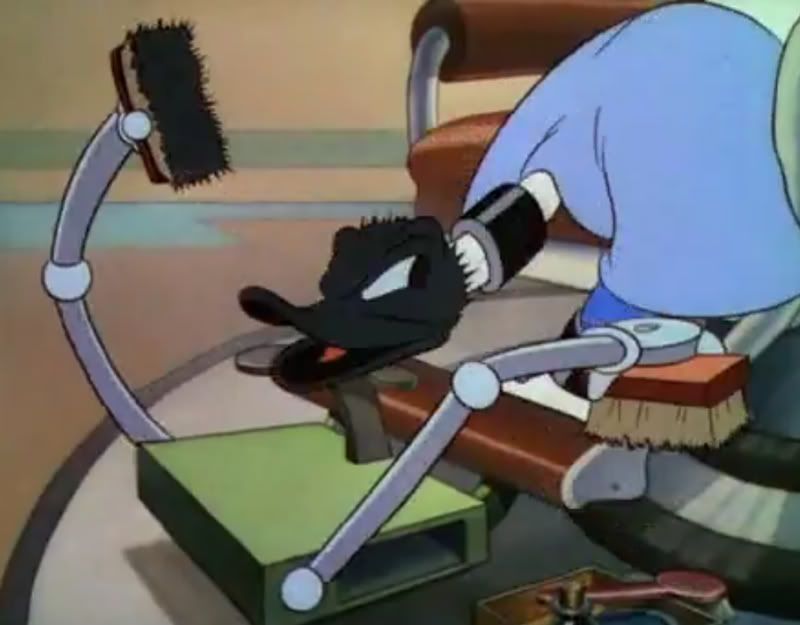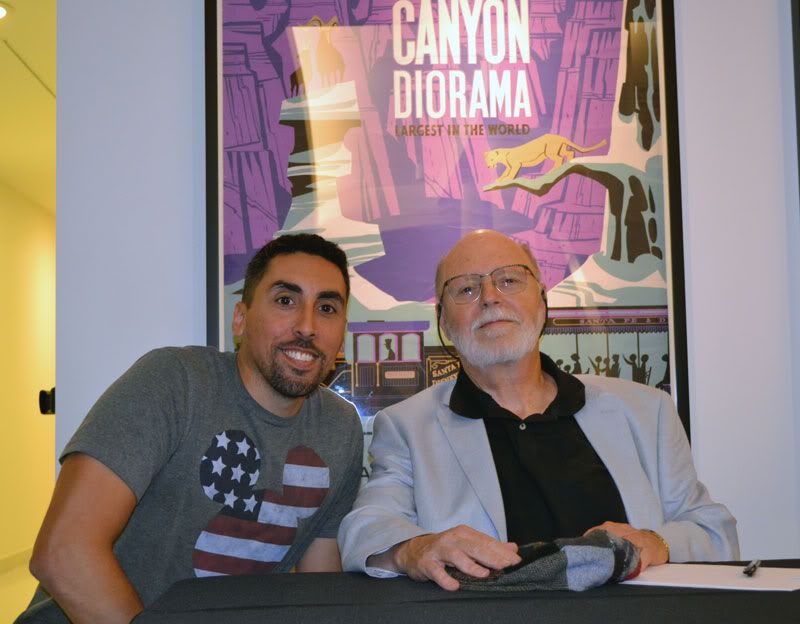On Saturday, August 13th, I attended a presentation at the Walt Disney Family Museum called “Comedic Influences with J.B. Kaufman and Russell Merritt.” It was all about how Walt Disney used popular comedic influences from his day and correlated them into the Mickey Mouse and Silly Symphonies cartoons. I am a pretty decent movie buff, but I know very little about non-Disney films before the 70’s (okay, nothing really before Star Wars). I don’t dislike old movies, I just don’t enjoy them as much. So needless to say I had a lot to learn by going to this presentation.
 |
| Again, the only pic I was allowed to take! |
J.B., Disney historian and author (Walt in Wonderland, South of the Border with Disney), started things off. He showed us several film clips featuring comedians of the 1930’s, mostly Charlie Chaplin. He followed many of them with a Disney cartoon that seemed to have its own take on each of the performances, even if it was something as simple as a nuance. For example, look at the end of Mickey’s The Barn Dance (1929). In it, Pegleg Pete and Mickey Mouse battle it out for Minnie Mouse’s affection. Originally the animators had planned for the story to end with Mickey and Pete kicking each other as Minnie stormed off. Walt sent them a memo stating, “I don’t think much of the kicking stuff. Maybe try some cute forlorning and a sigh of disgust.” In the end, Mickey’s inability to avoid crushing Minnie’s feet while dancing cost him the date. He turned to the camera and his eyes welled up with tears. It was cuter than a kicking contest, but it wasn’t quite Mickey, Walt felt.
Disney decided to start infusing comedic influences of the day, such as Harry Langdon and Charlie Chaplin. In the end of The Tramp (1915), Chaplin is seen walking away, dejected. At first his head is down, and even from behind you can see he is defeated. But all of a sudden he stops, lifts his head, kicks up his legs and strolls off. He had decided that things weren’t so bad after all, and Walt felt this is how Mickey ought to react to hardships.
Speaking of Chaplin, the 1930 cartoon The Firefighters was Disney’s spin on the bumbling fireman antics made popular by Chaplin’s 1916 short The Fireman. In Fireman, Chaplin does everything wrong on his way to the fire, from losing the fire engine piece by piece en route, to battling the hose instead of the fire upon arrival. Mickey also loses the fire engine one piece at a time on his way to the fire, but has to do battle with an uncooperative fire hydrant instead of a hose. Five years later, however, in the color short Mickey’s Fire Brigade (1935), Mickey would indeed have his battle with the infamous “out of control hose.” But Disney used this scene to take advantage of the fact that it was cartoon and not live action, and beautifully animated Mickey’s struggle while playing with both height and perspective.
 |
| YouTube this cartoon! It's a very cool short. |
J.B. passed the mic to Russell (fellow Disney historian and co-author of Walt in Wonderland), and he began by telling us how Walt loved the gags in films by Charlie Bowers and Buster Keaton, the latter of which featured a humorous, over elaborate labor-saving contraption (used by Keaton’s sidekick) in the film Go West (1925). In fact a few years before West, Disney used a contraption in one of his very first animated shorts ever, the Laugh-O-Gram version of Goldilocks and the Three Bears (1922).
Think Walt didn’t appreciate Buster Keaton? Steamboat Willie (1928) derived its name from the 1928 Keaton film Steamboat Bill Jr. (Keaton played Bill Jr., who was referred to as Willie in the movie).
Russell went on to inform us that in the early 1930s, many studios tried to put a comic face on The Great Depression. Walt led the way with his interpretation of The Three Little Pigs (1932). In Pigs the Big Bad Wolf is a sinister character who (among other things) wanted to take away your house, which was one of the most common fears during that time. Three Little Wolves (1936), the second sequel to Pigs, opened with Chaplin’s Modern Times. In Times, Chaplin is a factory worker who is “assaulted” by modern technology.
 |
| Poor Charlie |
One year later, Disney released a Donald Duck cartoon called Modern Inventions (1937). In Inventions, Donald Duck gets assaulted by, you guessed it, technology!
 |
| "Shine your shoes, guvenuh?" |
After the presentation, the two men opened up the floor to Q&A. Here are a few tidbits gathered from that session:
-By the mid 1930s Walt Disney and Charlie Chaplin were well acquainted and shared a great deal of mutual respect for one another.
During Q&A when asked if in addition to films influencing cartoons, did any cartoons influence films, they responded with:
-In Go West, Buster Keaton dressed up and walked like Felix the Cat in one scene.
-One of the producers on the Laurel and Hardy film Babes in Toyland (1934) was friends with Walt Disney. Because of that he was allowed to use an instrumental version of “Who’s Afraid of the Big Bad Wolf” during a scene that featured three “little” pigs. There was also a monkey in the film dressed up as Mickey Mouse.
-The Wizard of Oz (1939) probably wouldn’t have been made the way it was if it hadn’t been for the success of Snow White.
-Russian filmmaker Sergei Eisenstein was another of Walt’s many admirers. So much so he patterned the opening of his film Alexander Nevsky (1938) after the Silly Symphony The Skeleton Dance (1929). He also proclaimed that Snow White and the Seven Dwarfs was, “The greatest movie ever made.”
After the Q&A it was picture/autograph time. I of course forgot my copy of “South of the Border with Disney,” but I wanted to snap a few pics and ask a follow-up question or two. I have read several Walt Disney biographies, but at the time I couldn’t recall if Walt had any specific favorite movies or comedians. Russell also said that he wasn’t sure if Walt had a #1, but he mentioned the standards of those days: Chaplin, Marx Brothers, W.C. Fields. He did add something though: He said that when Walt was once asked a similar question, Walt seemed to make special mention of the actor Harold Lloyd. While it wasn’t clear that he was specifically Walt’s favorite, Russell found it interesting that Walt singled him out. And I do too!
Picture time!
 |
| Hangin' with Russell |
And my cousin Brian (who you all first met in this Splash pic) wanted in on the pic action as well.
 |
| Keith, J.B., Brian |
Thank you J.B. Kaufman and Russell Merritt for a very fun and interesting afternoon. And good news for anyone who happens to live in the Bay Area: J.B. and Russell compiled so much information for this presentation, they didn’t have time to use it all! They will be doing a follow-up presentation soon.
I love it.
ReplyDelete